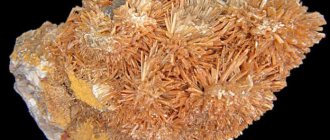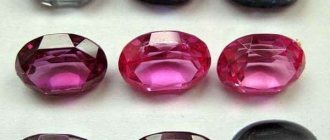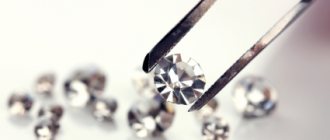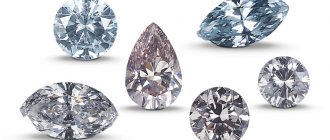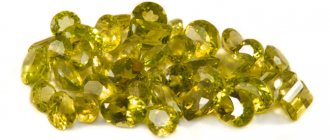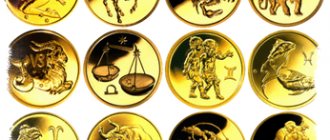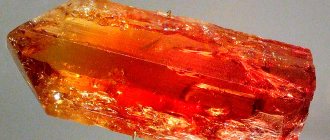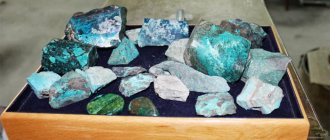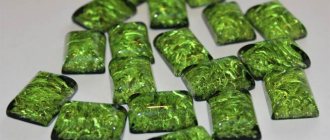History and origin
The British scientist William Heidinger first described siderite as an independent mineral in 1845, after studying samples from deposits in South Wales and Yorkshire. But siderite gained fame in the early Middle Ages, where even then it was used by ancient metallurgists, taking advantage of its availability, ease of extraction and wide distribution.
Mineral – Siderite
Siderite refers to minerals formed by hydrothermal processes occurring at medium or shallow depths of the earth's crust with the participation of hot aqueous solutions and high pressures.
Deposits and production
Siderite is an important component in ferrous metallurgy (steel production); it is mined from existing deposits around the world:
- Czech mines in Pribram,
- Portuguese - in Panaksheira,
- Russian - in the Urals (Bakal, Chelyabinsk region),
- German - in Siegerland,
- Italian - in Nurre, Frigido, Brosso and Traverselle,
- Canadian mines of Mont Saint-Hilaire,
- Ivigtut cryolite mine (Greenland),
- Canadian Mont Saint-Hilaire (province of Quebec),
- Austrian - Eisenerz (Styrian land) and Hüttenberg (Carinthian land),
- British - Tevistock (Devonshire) and on the Cornish Peninsula.
Place of Birth
Deposits of industrial importance have mostly already been developed. Russian siderite deposits: Akhtinskoye and Bakalskoye (Urals), Angaro-Pitskoye (Eastern Siberia), deposits of the Kursk magnetic anomaly and others.
Foreign siderite deposits:
Beautiful crystals come from the Brosso and Traversella mines, from Canavese (province of Turin), from the Frigido mine (province of Massa Carrara) and from a number of Sardinian mines, especially Nurra (province of Sassari). The most famous deposits of siderite are Panashqueira (Portugal); Potenberg, Erzberg, Eisenerz in Styria and Hüttenberg in Carinthia (Austria);
Pribram in Bohemia (Czech Republic); Müsen near the city of Siegen, Westphalia (Germany); Tevistock in Devonshire, Camborne Redruth on the Cornwall peninsula (UK). Also famous are the beautiful spar-like masses in the Ivigtut cryolite deposit in Greenland and the beautiful crystals from Mont-Saint-Hilaire, Quebec (Canada).
Siegerland (North Rhine-Westphalia, Germany) - veins of iron spar in the Rhine Slate Mountains with layers up to 30 m thick. Lumpy sedimentary siderites are known in England (Wales), Westphalia and Thuringia (Germany), and in France. In Eisenerz (Austria), as well as in England, USA.
Physical properties
It belongs to sedimentary minerals, 48% of its composition is pure iron. It is curious that heating does not melt siderite, but only changes its color: it becomes dark brown or black.
| Property | Description |
| Formula | FeCO3 |
| Hardness | 3,5 — 4,5 |
| Density | 3.96 g/cm³ |
| singonia | Trigonal |
| Kink | Conchoidal, uneven, stepped |
| Cleavage | Perfect |
| Shine | Glass |
| Transparency | Translucent |
| Color | Tan, brown, gray, yellowish gray, greenish gray |
Physico-chemical characteristics
According to the chemical classification, siderite is an iron carbonate of sedimentary, hydrothermal or metamorphic origin. Varieties of stone contain impurities, which is reflected in the corresponding formula.
The fracture is conchoidal or stepped.
| Color | Yellow, yellowish-gray, brownish-gray, brownish-yellow, brown, black |
| Stroke color | white |
| origin of name | From Greek sideros, glandular |
| Opening year | known since ancient times |
| IMA status | valid, first described before 1959 (before IMA) |
| Chemical formula | FeCO3 |
| Shine | glass mother-of-pearl silky |
| Transparency | translucent translucent translucent translucent |
| Cleavage | perfect perfect by {1011} |
| Kink | conchoidal stepped |
| Hardness | 3,5 4 4,5 |
| Thermal properties | Does not melt, becomes cracked, turns brown and black (due to iron oxidation) |
| Typical impurities | Mn,Mg,Ca,Zn,Co |
| Strunz (8th edition) | 5/B.02-40 |
| Hey's CIM Ref. | 11.13.1 |
| Dana (7th edition) | 14.1.1.3 |
| Dana (8th edition) | 14.1.1.3 |
| Molecular weight | 115.86 |
| Cell Options | a = 4.6916Å, c = 15.3796Å |
| Attitude | a:c = 1 : 3.278 |
| Number of formula units (Z) | 6 |
| Unit cell volume | V 293.17 ų |
| Twinning | Lamellar twins along (0112) are not common; a translational slip shift along {0001} or {1011} is typical. Also on {0001}, but very rarely. |
| Point group | 3m (3 2/m) – Hexagonal Scalenohedral |
| Space group | R3c (R3 2/c) |
| Density (calculated) | 3.932 |
| Density (measured) | 3.96(1) |
| Optical axis dispersion | strong |
| Refractive indices | nω = 1.875 nε = 1.633 |
| Maximum birefringence | δ = 0.242 |
| Type | single-axis (-) |
| Optical relief | high |
| Selection form | Siderite crystals are not very common; they are usually simple rhombohedrons, with saddle-shaped or lens-shaped curvature of the faces; flattened rhombohedra; Occasionally one comes across prismatic crystals or scalenohedrons. Spar-like coarse- or fine-grained mixed aggregates are more common; fine-grained dense aggregates; spherulites (spherosiderite), spherical or kidney-shaped spherulite aggregates of radial structure, as well as concretionary, granular or globular formations. Also dense masses, often shapeless accumulations mixed with clay (clay iron ore). |
| Selection form | granular masses |
| Classes on taxonomy of the USSR | Carbonates |
| IMA classes | Carbonates |
| singonia | trigonal |
| Fragility | Yes |
Siderite flotation has been well studied and used in industry.
Areas of application
Depending on the purpose and purpose, this iron-containing mineral has both extensive and local applications in various fields.
Siderit extensively uses:
- Ferrous metallurgy - as a “premium” class material for steel production, due to the absence of sulfur and phosphorus in its composition;
- Mining industry - in cementing wells located in productive formation zones. It is used to increase the density of the drilling fluid.
Limited use of the mineral:
- production of jewelry, amulets and talismans;
- use in collections of mineral lovers;
- in folk medicine and healing;
- during magical rituals (using attributes of magic from siderite).
Where is the mineral used?
Due to the fact that it contains more than 50% iron, the ore is easy to mine and easy to use in production, it is very popular in metallurgy. The absence of sulfur and phosphorus in the structure greatly improves the quality of manufactured products.
Siderite does not dissolve in water, but in mineral acids, especially in heated hydrochloric acid, this process occurs easily
In the mining industry, siderite is used as a basis in the preparation of special solutions for drilling wells. This mixture is poured into layers of waste rock. Granulated or crushed stone is a filler for an absorbent mixture that removes various impurities and sulfur compounds from gas and oil drilling wells.
The mineral is of no value and is not a precious stone, despite this, jewelers and collectors of rare stones are very interested in it. It does not undergo the cutting process because its natural three-dimensional cleavage prevents this. Half-transparent yellow or brown siderites are processed using emerald cutting, then displayed in collections and made into jewelry. Such accessories look very expensive and impressive. A variety of small crafts are often made from this material: figurines, souvenirs, carved crafts, smooth round stones.
Types of stone
Based on the presence of impurities and associated rocks in the mineral, it is known for the following types:
- clayey - common in shale and clay soils. They have the appearance of dense or fine-grained intergrowths and aggregates (crystals and grains);
- swamp - formed in swampy areas. They are accompanied by vivianites, calcinites and peat;
- carbonaceous - dark layers included (together with coal deposits) in the composition of shale clay;
- cobalt - containing cobalt oxide (about 9%);
- calcium or calcium - with a high content of calcium oxide (up to 10-12%);
- magnesium - containing magnesium oxide (about 12%);
- zinc-rich - with a small amount of zinc oxide (up to 1%);
- manganese – with isomorphic intergrowths of rhodochrosites and siderites, including manganese oxide up to 25%.
Also read: Carnelian - the meaning of the stone for a person
Varieties of siderite
The mineral is divided into varieties according to the content of impurities of various chemical elements:
- Calcium is the most common type of siderite, which includes at least ten subspecies, in which the proportion of calcium oxide can reach up to 12%.
- Magnesium is a stone mined in Norway with a magnesium oxide content of up to 11.7%.
- Zinc-bearing - siderite in which inclusions of zinc oxide exceed 0.5%.
- Cobalt - a mineral with an admixture of cobalt oxide within 9%.
- Manganese - the formation of a rock of isomorphic origin from rhodochrosite and siderite with an admixture of manganese oxide, the proportion of which can reach 25%.
Depending on the origin and accompanying rocks, the following types of siderite are distinguished:
- Claystone – fine-grained or dense stones found in shale and clayey rocks.
- Bolotny - siderite, formed in wetlands in close proximity to calcinite, peat and vivianite.
- Carbonaceous - forms in shale clay deposits next to coal deposits, forming a dark layer in the rock.
According to visual signs and formation features, siderite is divided into:
- Spherosiderite – nodules with a high content of clayey substances, characterized by a shape close to round;
- Colloidal siderite is a sinter-type aggregate that is formed from colloidal substances under the influence of sedimentary processes.
Back to contents
Medicinal properties
Traditional medicine and healing do not yet provide extensive recommendations on the use of siderite as a healing substance. There are only some recommendations for using siderite:
- in the treatment of colds and hypothermia (black minerals);
- with atonic constipation;
- for liver diseases;
- as an appetite enhancer.
Magic properties
Among mediums and magicians there are many connoisseurs of the enormous magical potential of siderite.
In their opinion, the high iron content in the mineral contributes to:
- development of the supernatural in humans;
- the emergence of telepathic abilities and clairvoyance;
- strengthening leadership qualities.
It is believed that magical talismans made from this mineral should be worn by brave people, with a fair amount of adventurism and fearlessness in their hearts:
- lovers of extreme sports and exotic sports;
- travelers;
- rescuers;
- climbers and divers.
According to magicians, a powerful flow of cosmic energy passes through siderite, and part of it is transferred to the owner of the talisman made from this stone. Both in ancient times and now, in the 21st century, magic balls and talismans are made from the mineral.
Healing and magical properties
Despite the insufficient study of siderite by traditional healers, the stone is still used in lithotherapy. Brown and yellow crystals have a positive effect on the functioning of the genitourinary system, kidneys and liver, increase appetite and normalize intestinal functions, relieving atonic constipation. By contacting black siderite, you can alleviate the condition of hypothermia and colds.
Siderite has a special magical power that can transform negative energy into positive energy. This is facilitated by the natural combination of iron with other chemical elements. The mineral is interesting to magicians and mediums, so they use products made from it to perform rituals. For example, with the help of siderite balls, sorcerers predicted the future. Charms in the form of a ring or pendant were used to protect against the evil eye and dark messages of ill-wishers.
In men, the stone develops masculinity and determination, making it attractive to women. With the help of siderite, the fair half of humanity can strengthen leadership qualities and decide on their position in life. A talisman with a mineral should be worn by those whose occupation is associated with risk and injury. These are travelers, athletes and stuntmen. Back to contents
Compatibility with other stones
Since siderite does not belong to precious or even semi-precious stones, and is fragile in use, it is practically not combined in products with other minerals. But among stone lovers and collectors, natural combinations of various stones and minerals, including siderite, are in demand.
It is found in extremely spectacular groups with the following stones:
- scherl (black tourmaline);
- calcite;
- sphalerite;
- chalcopyrite;
- tetrahedrite.
Several of the above-mentioned minerals can be combined in one piece at once, forming a beautiful ensemble in a variety of colors, with complex shades and textures. The cost of such collectible samples varies from 12-13 to 30-40 thousand rubles.
Types of siderite
Currently, there are several types of this mineral, which differ in the content of impurities, as well as in the accompanying rocks:
- Swampy - formed in swampy areas. Associated rocks: peat, vivianite and calcinite.
- Clayey – found in clayey soils and shales. Found in the form of dense or fine-grained aggregates, as well as nodules.
- Carbonaceous - located in shale clay, adjacent to coal deposits, forming dark-colored layers.
- Calcium or calcium. This category includes more than a dozen varieties of siderite with varying percentages of CaO2 (up to 12%).
- Cobalt – CoO content is up to 9%.
- Magnetic – MgO content is 11.7%. Siderite of this type is mined in the Norwegian Black deposit.
- Zinc-rich – ZnO content more than 0.5%.
- Manganese is an isomorphic aggregation of siderite and rhodochrosite, the MnO2 content is up to 25%.
Jewelry with minerals
Although siderite, in comparison with other stones, is very modest in appearance and is not a valuable stone, some jewelers are willing to work with it.
Also read: Grandidierite is a trichroic stone
Processed stone
With appropriate processing and cutting, siderite acquires silvery matte shades and looks rich. Brownish, wood-toned, translucent minerals and stones of dark, almost black tones are also used.
The peculiarities of the natural properties of siderite do not allow applying a diamond cut to it, but only an emerald, stepped, octagonal shape of the mineral. It is cut to within five carats.
ATTENTION. As a mineral with a strong magical effect, siderite is best suited for jewelry in the form of bracelets, beads and pendants.
The cost of siderite jewelry is low and is available to a wide range of buyers. The price ranges from 350 to 16,000 rubles, taking into account the size and quality of the product.
How to distinguish a fake?
Siderite is not so often used in jewelry and jewelry made from it is inexpensive, so it is doubtful that the faceted mineral will be counterfeited.
Collection copies from a reputable seller must be protected by an appropriate certificate. And you can always use one method or another to determine the authenticity of an acquisition.
There are some simple and accessible ways to distinguish a genuine stone from a plastic, ceramic or other fake:
- Heat check. Natural stones are cold; by placing any of these stones on the lips or chin, the examiner will feel the cold for a few seconds. Artificial plastic and ceramics will heat up almost immediately.
- Hearing or sound testing. By tapping a natural stone on glass or metal, you can hear a characteristic sound, unlike that produced by counterfeit materials.
- Weight check. Natural stone is always heavier than a counterfeit “analog” of the same size.
ATTENTION. It is recommended to use ordinary road pebbles - an affordable natural stone - as a test sample.
A gemologist can guarantee the authenticity of a mineral by conducting testing using special equipment.
How to wear and care rules
The boundaries of the modern dress code are becoming more conventional and democratic. Therefore, an excellent addition to a men's business suit, for example, would be strict and stylish cufflinks made of modest but effective dark siderite.
Bracelets, pendants and beads made from this mineral are also suitable for lovers of casual and boho styles. A bold play on contrasts in most styles is also appropriate: a bright dress (blouse) and a black bracelet or beads in discreet smoky shades.
Caring for products made from this mineral will not take much time and will not require special tools and equipment:
- siderite, as a soft mineral, should be protected from mechanical damage and should be stored in a special case, separately from other products;
- Do not expose it to direct sun;
- As a care product, use a slightly warm soap solution and a soft microfiber cloth.
Also read: Sphalerite - the possibilities of the stone and its areas of use
Siderite and Zodiac signs
According to most astrologers, siderite generally has a neutral effect on all signs of the Zodiac, except those related to the air element: Gemini, Aquarius and Libra.
IMPORTANT. It is better for Air signs to avoid prolonged contact with the mineral, which can weaken their energy and worsen their well-being.
The signs of the Earth element are under the strong positive influence of the mineral:
- Taurus;
- Virgo;
- Capricorns.
The stone will help these signs:
- awaken and activate unexpected talents;
- strengthen the spirit and give confidence in decisive and important steps in life;
- develop or strengthen intuition;
- improve material wealth.
ATTENTION. It is also necessary to take into account individual compatibility with the stone, regardless of the zodiac sign under which the person was born. Astrologers advise to be careful about your personal interaction with minerals.
Is this stone right for you?
Magical Features
Perhaps the presence of iron atoms in the composition of siderite contributed to the emergence of the opinion that this stone is a talisman for hardened people - travelers, rangers, extreme sports enthusiasts. It is believed that their siderite reduces the level of injuries.
The energy of the cosmos, passing through the mineral, saturates its owner, making him stronger and more resilient.
Iron itself is considered the metal of Mars and is widely used in magic. Spar iron ore has protective properties. Magicians and sorcerers use it for protective purposes, to cleanse and scare away ghosts, demons, and ghostly entities. They believe that an iron pin or a piece of siderite attached to the door will not allow evil people, witches and sorcerers into the home. An iron horseshoe helps to attract wealth and prosperity.
There is a belief that iron powder protects the house and its inhabitants from the negative influence of the other world.
Ancient times believed that thanks to the “pure iron” that is contained in the stone, a person’s clairvoyant abilities awaken. It is for this reason that in the Middle Ages magic balls and other paraphernalia for rituals were made from siderite.
Black magicians drove people away from the developed places by spoiling the energy of the earth. They stuck rusty nails in the garden and uttered evil words. As a result, the garden stopped producing crops.
After an unpleasant conversation, you need to imagine an iron object in your palm and mentally give it all the negativity and negative emotions you have received.
Interesting things about the stone
- Even in ancient times in Crimea, siderite served as a raw material in the preparation of paint. The so-called Feodosia brown has long been known and popular among artists. And among local residents, since time immemorial, homemade paint for household use has been in use. Mineral deposits have been repeatedly developed by the largest artistic paints factory from St. Petersburg. In the vicinity of Feodosia, to this day there are deposits used for the extraction of mineral aggregates (clusters of crystals and mineral grains). Siderite pigments are used to color ceramics, glass, porcelain, linoleum, and are used in the production of colored pencils and the leather industry.
- In the 20th century, the Crimean stones were given the name “Cimmerians” - after the ancient aborigines of those places. Magnificent examples of the “Cimmerians” are kept in the local history museum of Simferopol.
- Spectacular and rare beautiful specimens of siderite for the collections of connoisseurs and mineral lovers are found in Quebec and Greenland, Canada.
